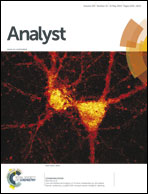Rhodamine based dual probes for selective detection of mercury and fluoride ions in water using two mutually independent sensing pathways†
Abstract
New rhodamine based molecules have been designed as dual probes for the ppb-level selective detection of Hg2+ and F− ions in aqueous medium at physiological pH 7.4. The probes have been designed in such a way to utilize both the properties of the metal ion induced ‘turn-on’ detection mechanism of the spirolactam ring opening of the rhodamine moiety and the reaction based cleavage of the O-silyl bond in presence of the fluoride ion. The probes have been synthesized conveniently by coupling rhodamine hydrazone with O-silyl protected mono- and di-hydroxybenzaldehydes. Both the probes showed a ‘turn-on’ detection of the fluoride ion due to the cleavage of the O-silyl bond upon treatment with the added F− ion. However, the probes showed selective ‘turn-on’ detection of Hg2+ ion by opening of the spirolactam ring. The two detection mechanisms worked in isolation and hence the corresponding spectral responses appeared completely independent of each other. The presence of Hg2+ in solution induced generation of an intense pink color with bright green fluorescence emission. In contrast a deep yellow color with yellow fluorescence was observed upon addition of the fluoride ion to the probe solution. Two different mechanisms of interactions have been proposed on the basis of 1H-NMR, IR and mass spectrometric studies. Thus, using a single probe the selective sensing of two different ions could be achieved in aqueous medium well below their permitted limit of detection.


 Please wait while we load your content...
Please wait while we load your content...